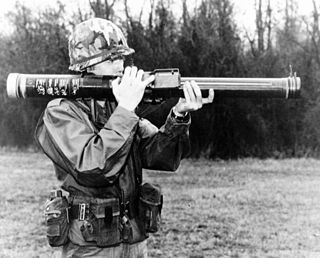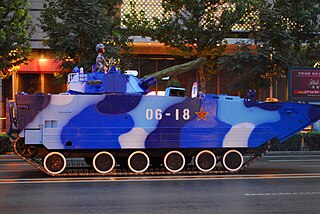
An armoured fighting vehicle (AFV) is an armed combat vehicle protected by armour, generally combining operational mobility with offensive and defensive capabilities. AFVs can be wheeled or tracked. Main battle tanks, armoured cars, armoured self-propelled guns, infantry fighting vehicles and armoured personnel carriers are all examples of AFVs.

Self-propelled artillery is artillery equipped with its own propulsion system to move towards its firing position. Within the terminology are the self-propelled gun, self-propelled howitzer, self-propelled mortar, and rocket artillery. They are high mobility vehicles, usually based on continuous tracks carrying either a large field gun, howitzer, mortar, or some form of rocket/missile launcher. They are usually used for long-range indirect bombardment support on the battlefield.

A tank is an armoured fighting vehicle intended as a primary offensive weapon in front-line ground combat. Tank designs are a balance of heavy firepower, strong armour, and good battlefield mobility provided by tracks and a powerful engine; usually their main armament is mounted in a turret. They are a mainstay of modern 20th and 21st century ground forces and a key part of combined arms combat.

The Merkava is a main battle tank used by the Israel Defense Forces. The tank began development in 1970, and entered official service in 1979. Four main variants of the tank have been deployed. It was first used extensively in the 1982 Lebanon War. The name "Merkava" was derived from the IDF's initial development program name.

The T-64 is a Soviet second-generation main battle tank introduced in the early 1960s. It was a more advanced counterpart to the T-62: the T-64 served in tank divisions, while the T-62 supported infantry in motorized rifle divisions. It introduced a number of advanced features including composite armor, a compact engine and transmission, and a smoothbore 125-mm gun equipped with an autoloader to allow the crew to be reduced to three so the tank could be smaller and lighter. In spite of being armed and armored like a heavy tank, the T-64 weighed only 38 tonnes.

The BMP-1 is a Soviet amphibious tracked infantry fighting vehicle. BMP stands for Boyevaya Mashina Pekhoty 1, meaning "infantry fighting vehicle, 1st serial model". The BMP-1 was the first mass-produced infantry fighting vehicle (IFV) of the Soviet Union. It was called the M-1967, BMP and BMP-76PB by NATO before its correct designation was known.

Anti-tank warfare originated from the need to develop technology and tactics to destroy tanks during World War I (1914–1918). Since the Triple Entente developed the first tanks in 1916 but did not deploy them in battle until 1917, the German Empire developed the first anti-tank weapons. The first developed anti-tank weapon was a scaled-up bolt-action rifle, the Mauser 1918 T-Gewehr, that fired a 13mm cartridge with a solid bullet that could penetrate the thin armor of tanks of the time and destroy the engine or ricochet inside, killing occupants. Because tanks represent an enemy's greatest force projection on land, military strategists have incorporated anti-tank warfare into the doctrine of nearly every combat service since. The most predominant anti-tank weapons at the start of World War II in 1939 included the tank-mounted gun, anti-tank guns and anti-tank grenades used by the infantry, as well as ground-attack aircraft.

The T-84 is a Ukrainian main battle tank (MBT), a development of the Soviet T-80 main battle tank introduced in 1976. The T-84 was first built in 1994 and entered service in the Ukrainian Armed Forces in 1999. The T-84 is based on the diesel-engined T-80 version, the T-80UD. Its high-performance opposed-piston engine makes it one of the fastest MBTs in the world, with a power-to-weight ratio of about 26 horsepower per tonne. The T-84 Oplot is an advanced version incorporating an armoured ammunition compartment in a new turret bustle; ten of these entered Ukrainian service in 2001. The T-84-120 Yatagan is a prototype model intended for export, mounting a 120 mm gun capable of firing standard NATO ammunition and guided missiles.

The PT-76 is a Soviet amphibious light tank that was introduced in the early 1950s and soon became the standard reconnaissance tank of the Soviet Army and the other Warsaw Pact armed forces. The world's first mass-produced amphibious medium tank, it was widely exported to other friendly states, like India, Iraq, Syria, North Korea and North Vietnam. Overall, some 25 countries used the PT-76.

Aerial firefighting is the use of aircraft and other aerial resources to combat wildfires. The types of aircraft used include fixed-wing aircraft and helicopters. Smokejumpers and rappellers are also classified as aerial firefighters, delivered to the fire by parachute from a variety of fixed-wing aircraft, or rappelling from helicopters. Chemicals used to fight fires may include water, water enhancers such as foams and gels, and specially formulated fire retardants such as Phos-Chek.
This is a glossary of firefighting equipment.

The T-44 is a medium tank first developed and produced near the end of World War II by the Soviet Union. It was the successor to the T-34, offering improved ride and cross-country performance and much greater armor. Designed to be equipped with an 85 mm main gun, by the time it was fully tested the T-34 had also moved to this weapon. Both tanks offered similar performance, so introducing the T-44 was not considered as important as increasing T-34 production. Fewer than 2,000 T-44s were built, compared to about 58,000 T-34s. Although the T-44 was available by the end of the war, it was not used in combat. However, if it were used in combat it would have been a significant upgrade to the T-34. Its upper front plate could withstand a hit from the German 88mm guns found on the Tiger I and Tiger II. It was also 1 ton lighter than the T-34-85 and slightly faster.

The Al-Khalid is a main battle tank jointly developed by Pakistan and China during the 1990s, based on the Chinese Type 90-IIM tank. The original prototype was developed by China North Industries Corporation (Norinco) under the name MBT-2000, and Norinco also offered the tank for export. Around 310 Al Khalid MBTs had been produced by 2014. The Bangladesh Army ordered 44 MBT-2000s from China in 2011. The Norinco-made MBT-2000 is also used by the Royal Moroccan Army. It was trialled by the Peruvian Army for possible acquisition, but was not purchased due to financial problems.

The K21 is a South Korean infantry fighting vehicle. A replacement for the K200-series, it was formerly designated as K300 or XK21 KNIFV. The initial production began in 2009, with the Republic of Korea Army planning to field approximately 466 units. It is designed to effectively defeat other IFVs as heavily armed and armored as the BMP-3.

The Norinco Type 63 is a Chinese amphibious light tank. First fielded in 1963, it is in many ways similar to the earlier Soviet PT-76. However, contrary to the popular belief, it does have some essential differences from the PT-76 in the vehicle's waterjet propulsion system, etc. It is also known under its industrial designation, the WZ-211. Type 63 is being replaced by Type 63A.

The ZBD-04 or Type 04 is a Chinese infantry fighting vehicle. It bears some external resemblance to the BMP-3, particularly with regards to its turret and main armament; however, the chassis and internal subsystems possesses a different layout. The earliest prototypes received the designation ZBD-97. An improved version, ZBD-04A, is the vehicle currently in service and being produced.

An armoured personnel carrier (APC) is a broad type of armoured, military vehicle designed to transport personnel and equipment in combat zones. They are sometimes referred to colloquially as "battle taxis" or "battle buses". Since World War I, APCs have become a very common piece of military equipment around the world.

The Type 05 amphibious armored vehicle is a family of amphibious tracked armored fighting vehicles developed by Norinco for the People's Liberation Army Navy Marine Corps, consisting of two main combat variants — the ZBD-05 infantry fighting vehicle and the ZTD-05 assault vehicle, as well as two support variants based on the ZBD-05. The Type 05s could be launched at sea from an amphibious assault ship over the horizon, and features a hydroplane, a design concept that has been compared to the cancelled United States Expeditionary Fighting Vehicle (EFV) program.

A main battle tank (MBT), also known as a battle tank or universal tank, is a tank that fills the armor-protected direct fire and maneuver role of many modern armies. Cold War-era development of more powerful engines, better suspension systems and lighter weight composite armor allowed a tank to have the firepower of a super-heavy tank, armor protection of a heavy tank, and mobility of a light tank all in a package with the weight of a medium tank. Through the 1960s, the MBT replaced almost all other tanks, leaving only some specialist roles to be filled by lighter designs or other types of armored fighting vehicles.

This article on military tanks deals with the history of tanks employed by various military forces belonging to the Kuomintang and Communist Party of China within China. From the early half of the 20th century, tanks were initially obtained from other countries; eventually indigenously designed Chinese tanks started manufacture and became used during the Cold War and towards the modern era.


















